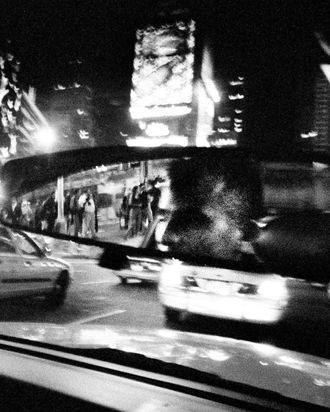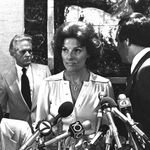
On the nastiest night of the year, in the frosty heart of the social calendar’s mid-December deluge, Jessica Seinfeld, cookbook author and wife of Jerry, paid $415 to have her children chauffeured to a bar mitzvah and a sleepover. “#OMG #neverforget #neveragain #real,” she wrote on Instagram, alongside a snapshot of the bill, in what might be considered an ironic display of outrage from a family worth an estimated $800 million.
The charge, however, did not come from your average car-and-driver arrangement but from the mobile app Uber, “Everyone’s Private Driver,” which, in a few iPhone swipes, pairs passengers with willing livery vehicles. “I thought my 172 bill that night was bad. WOW,” commented former CNN anchor Alina Cho on Seinfeld’s photo, which received more than 200 “likes” and a few sympathetic blog posts.
The reason for Seinfeld’s eye-bulging total — you could get from midtown to JFK and back three times for that much in a yellow cab — was Uber’s surge-pricing model, which jacks up fees using a secret algorithm on particularly busy days and nights. It’s Economics 101: Supply and demand dictates that when everyone wants to arrange a pickup at once, the dearth of available cars allows the company to charge more for its services; higher prices, the logic goes, incentivize more drivers to work during high-traffic times, like during inclement weather or rush hour, eventually bringing totals back down to normal.
The price inflation in New York was the result of a truly perfect storm: The app’s local boom in 2013 increased demand, as did the hellish weather and the Christmas-party-laden time of year. The result was fares multiplying up to eight times, some of the highest ever seen. New Yorkers accustomed to tightly regulated, typically hail-able metered cabs and an abundance of cheap, reliable public-transportation options — options other Uber markets decidedly lack — fueled December’s Uber backlash, which reverberated louder and longer than any previous whining about the pricing structure: “The Weekend Uber Tried to Rip Everyone Off,” crowed Valleywag; “Uber’s Snow Storm Surge Pricing Gouged New Yorkers Big Time,” declared Gothamist. New York’s Kevin Roose argued that the company should cap the charges at two or three times the standard rate in order to avoid alienating potential long-term customers. (It didn’t help that New York is also the nation’s media capital.)
“By raising the price you increase the number of cars on the road and maximize the number of safe convenient rides,” wrote Uber’s Ayn Rand–loving techno-evangelist of a CEO, Travis Kalanick, in a blog post. “Nobody is required to take an Uber, but having a reliable option is what we’re shooting for.” He may as well have been addressing his lesson on the invisible hand to Ms. Seinfeld, but that explanation came much earlier, way back in January of 2012, after a West Coast wave of similar indignation swelled in Uber’s hometown of San Francisco on New Year’s Eve. In three days, the company received about 200 e-mails and tweets complaining about sticker shock.
That was before New York was paying attention, when the app was still the Silicon Valley secret of early-adopting employees of Google and Facebook. Now Uber operates in 25 countries and 67 cities, fielding one million requests a week and fulfilling 800,000 of them, with leaked financials estimating $1 billion annually in gross bookings. (Drivers, who are not employed by Uber but just opt in to the software, take 80 percent of a fare, while Uber skims off 20 percent.) Along the way, New York City, despite having perhaps the best taxi system in the world, quietly became one of Uber’s biggest, fastest-growing markets. If New Yorkers are now familiar with Uber’s benefits — ease, dependability, and the ability to, in Kalanick’s parlance, “be baller,” they’re also starting to notice its limitations.
Uber remains resolute in its tactics and insistent about its transparency. When rates are multiplied, users are notified with a lightning-bolt icon and are reminded at least twice more about the surcharge, once via a “sobriety test” in which they must type the multiplier themselves before ordering a car. On Twitter, Kalanick spent hours responding to frustrated users, stressing his belief in the algorithm “even to our detriment in public sphere.” He retweeted supporters (“Do all the people bitching about Uber prices in NYC know they can take the subway for $2.50?”) and posted an e-mail exchange with another livid customer (“I AM OUTRAGED AND DISGUSTED”) on his personal Facebook page. “We are not setting the price. The market is setting the price,” Kalanick told Wired. “We did more trips because of our approach, not fewer. We gave people more options to get around, and that is the whole frickin’ goal.”
By most accounts, amplified social-media screaming aside, it’s working. “What’s kept me on Uber is the surge pricing,” says an Uber driver in San Francisco, who also occasionally works for Lyft, a more granola, couch-surfing-style competitor. “I haven’t had any negative feedback from passengers,” he says of the ramped-up charges. “They know what it is, they acknowledge it, and they get their ride anyway. In New York and San Francisco, young people are making a ton of money, and they don’t care. They just want to get to their dinner reservations on time.”
It’s a luxury service, available to anyone, in a traditionally conservative space, and therein lies the disconnect. Once upon a time, the patience, skill, and luck involved in hailing a cab during the worst of circumstances — or the commitment to taking the train, even if it required waddling through slush and black ice — were considered virtues. Smartphones make that late-night gamble seem insane, but there’s a premium to be paid for convenience. And it’s not just monetary: There’s also psychological grappling to be done with picking the easy, decadent option over the old-school transportation system that’s long worked just fine despite its quirks and inconveniences.
Those with the ability to pay more for comfort will do so; they just need some time to work out their feelings — sometimes in public — remorse and anger among them. Or that’s what Uber is counting on: Looking toward New Year’s Eve this time, the company instituted no major changes to its pricing plan, confident that desperate (enlightened?) New Yorkers with the means would pay whatever it takes, even if it hurts in the morning. Uber doesn’t take payments in cash, instead automatically charging a preset credit card digitally, which allows for some willful ignorance after a night of indulgence. Following a round on the New York City holiday-party circuit during the weekend snowstorm, a friend of mine was appropriately mortified when the surge criticism persuaded her to finally glance at her receipt ($67 for an eight-minute ride). The public grumbles the next day double as repentance, not unlike with a self-inflated bar tab and its accompanying hangover. An Uber bill just feels better with a bit of complaining, which works both to alleviate some guilt and alert others to your exploits.
The public posting of receipts like Seinfeld’s, then, can be therapeutic — part brag, part rage — especially in the light of day. “Love ya @uber, but $132.00 to get across town last night?! I’m not made of money!” Sports reporter Michelle Beadle added to the Twitter chorus at brunchtime on the Sunday after Uber’s peak prices. Ten minutes later, she added: “I’ll just expense it.”





























